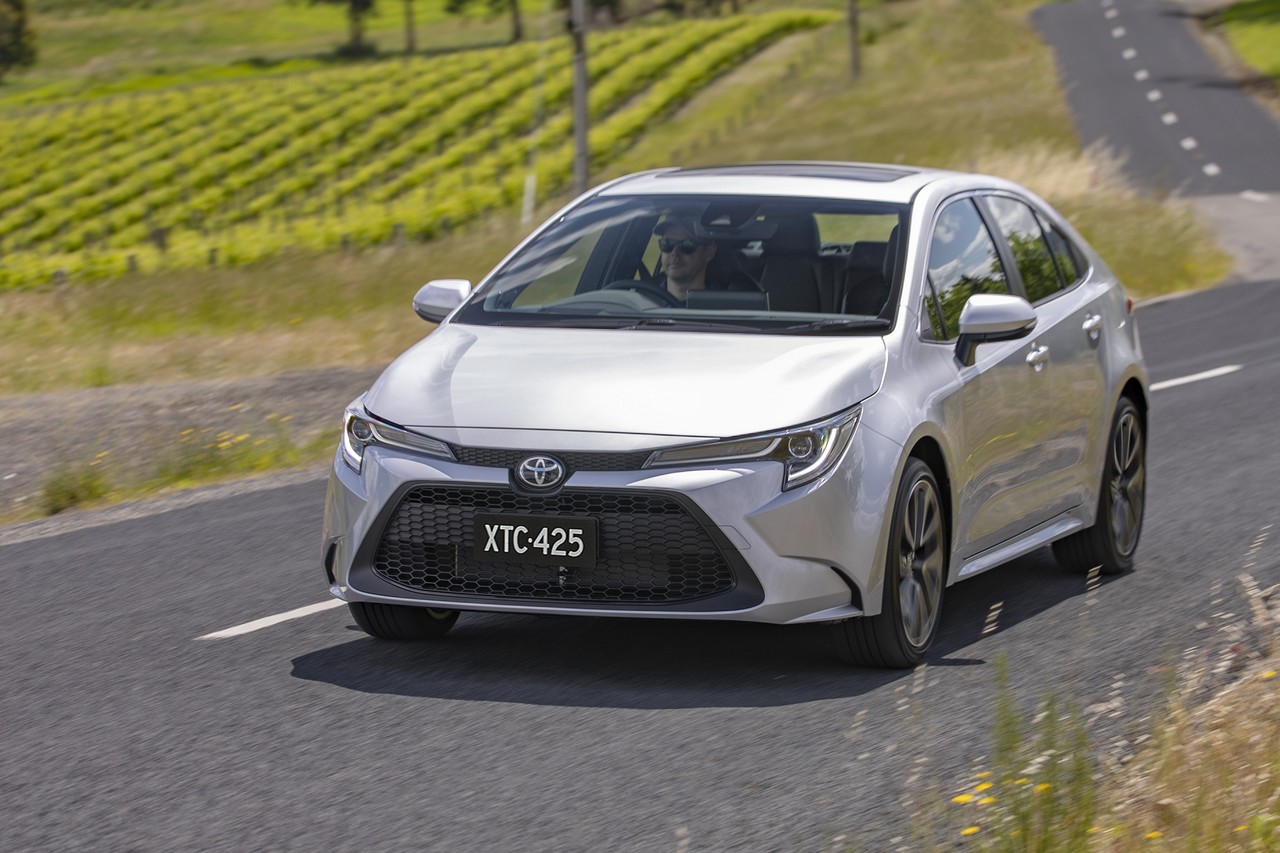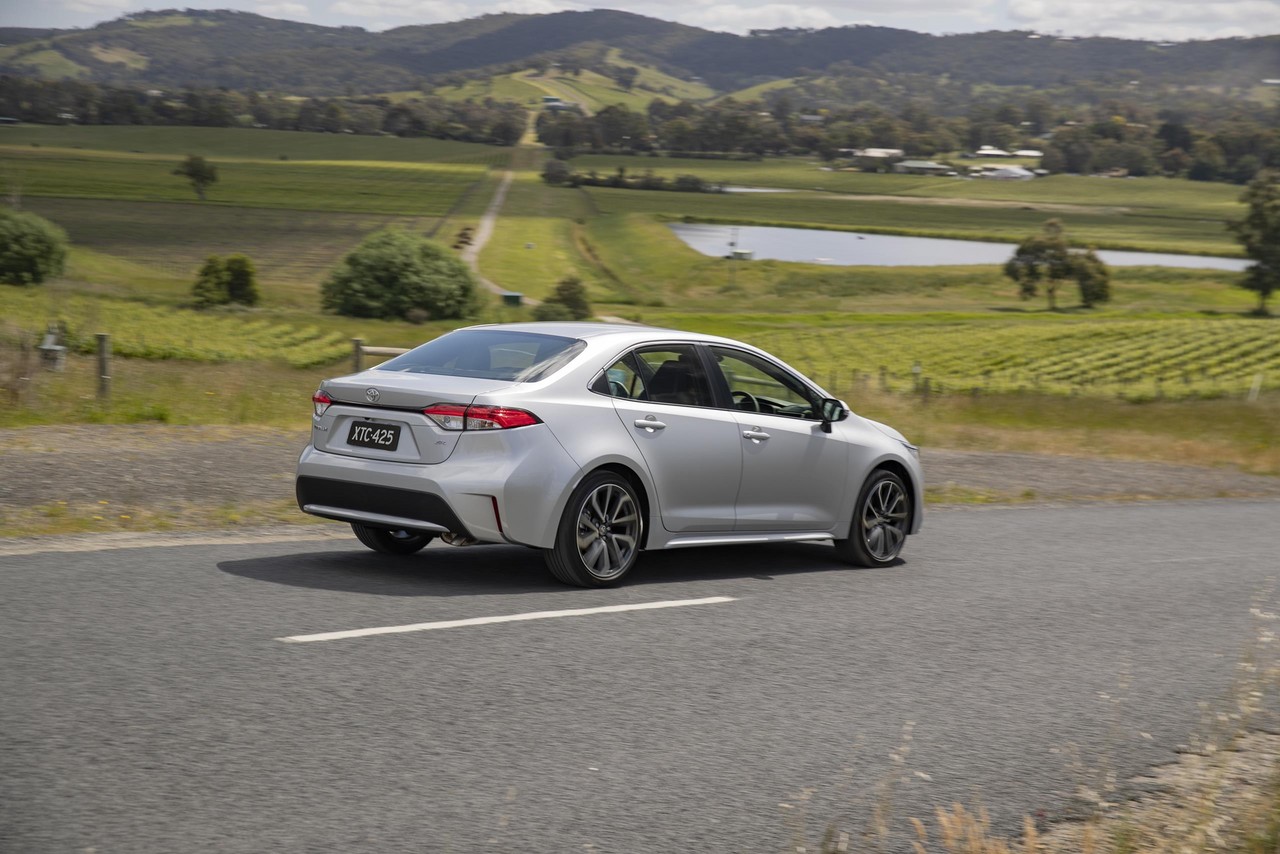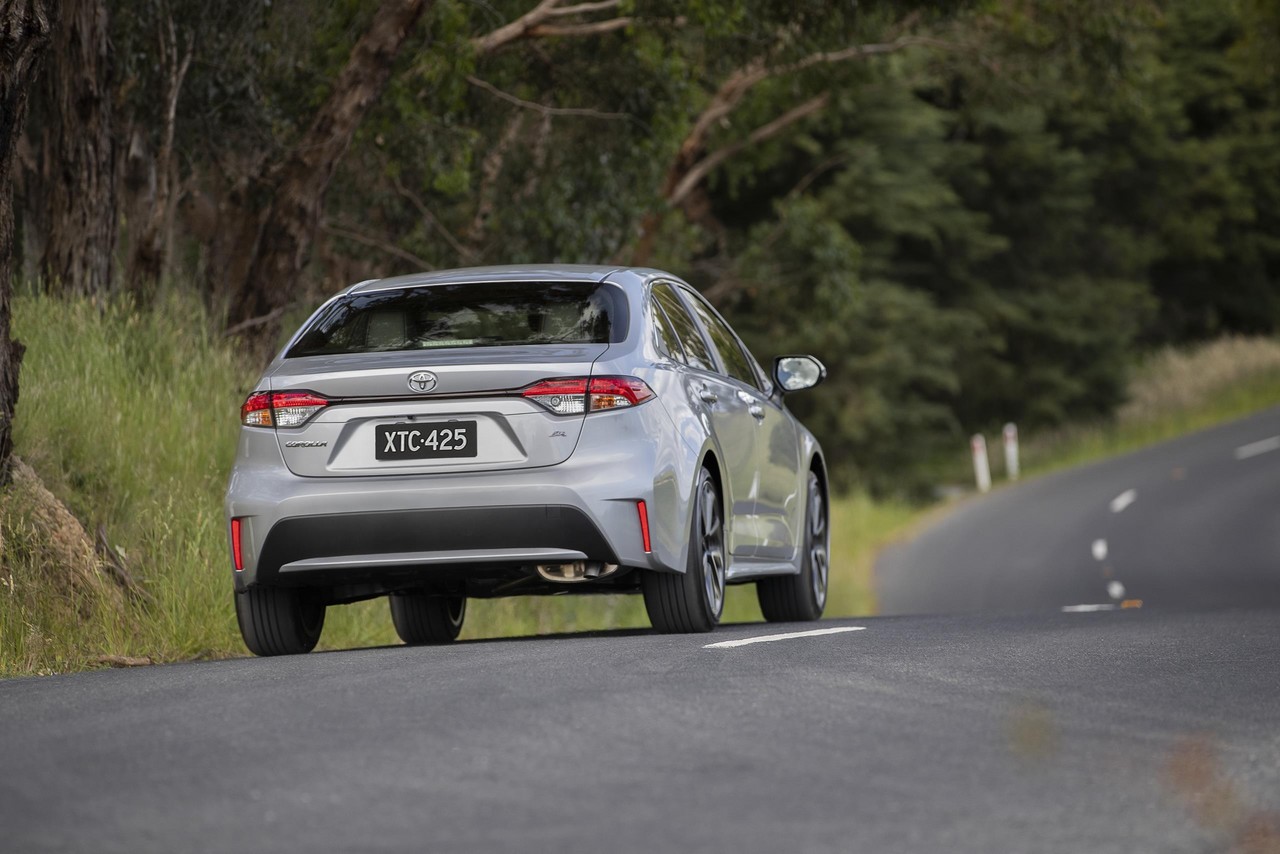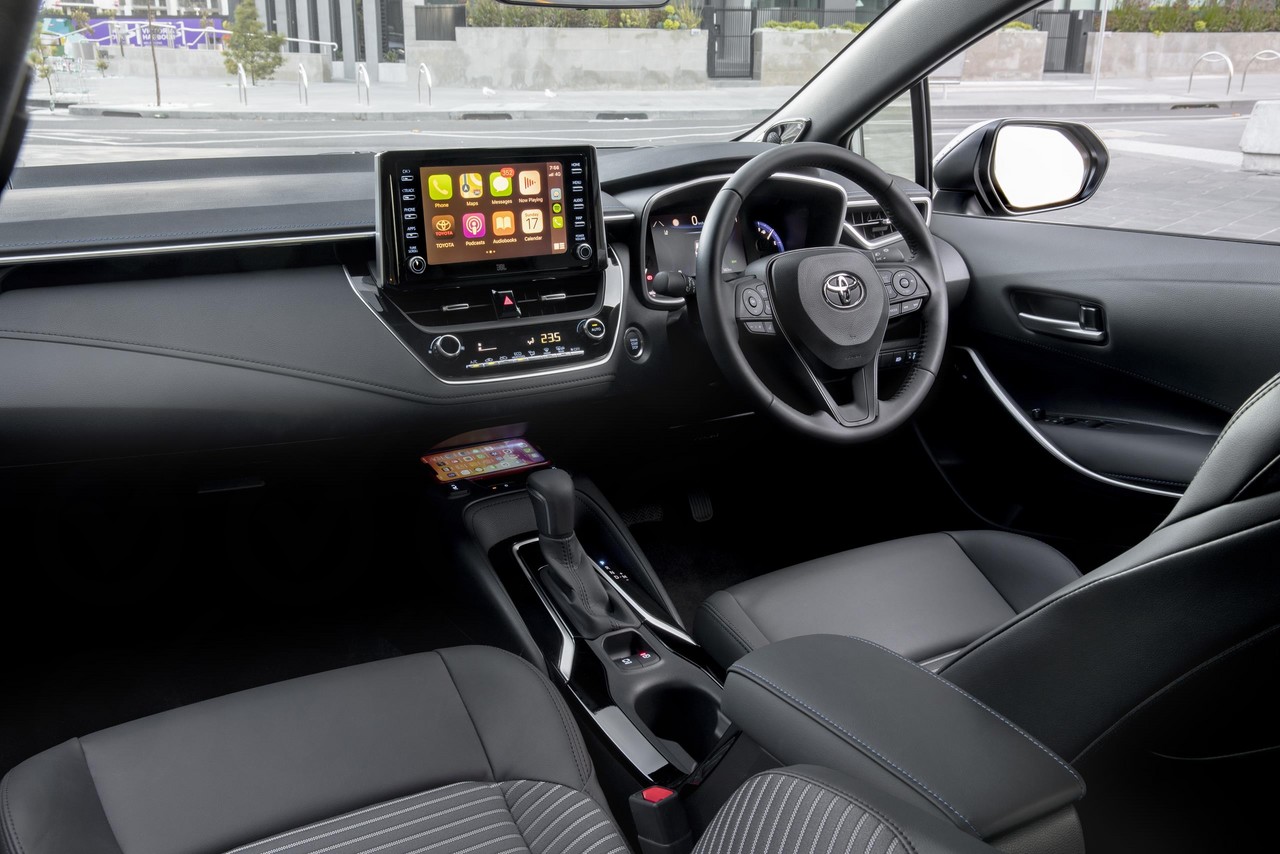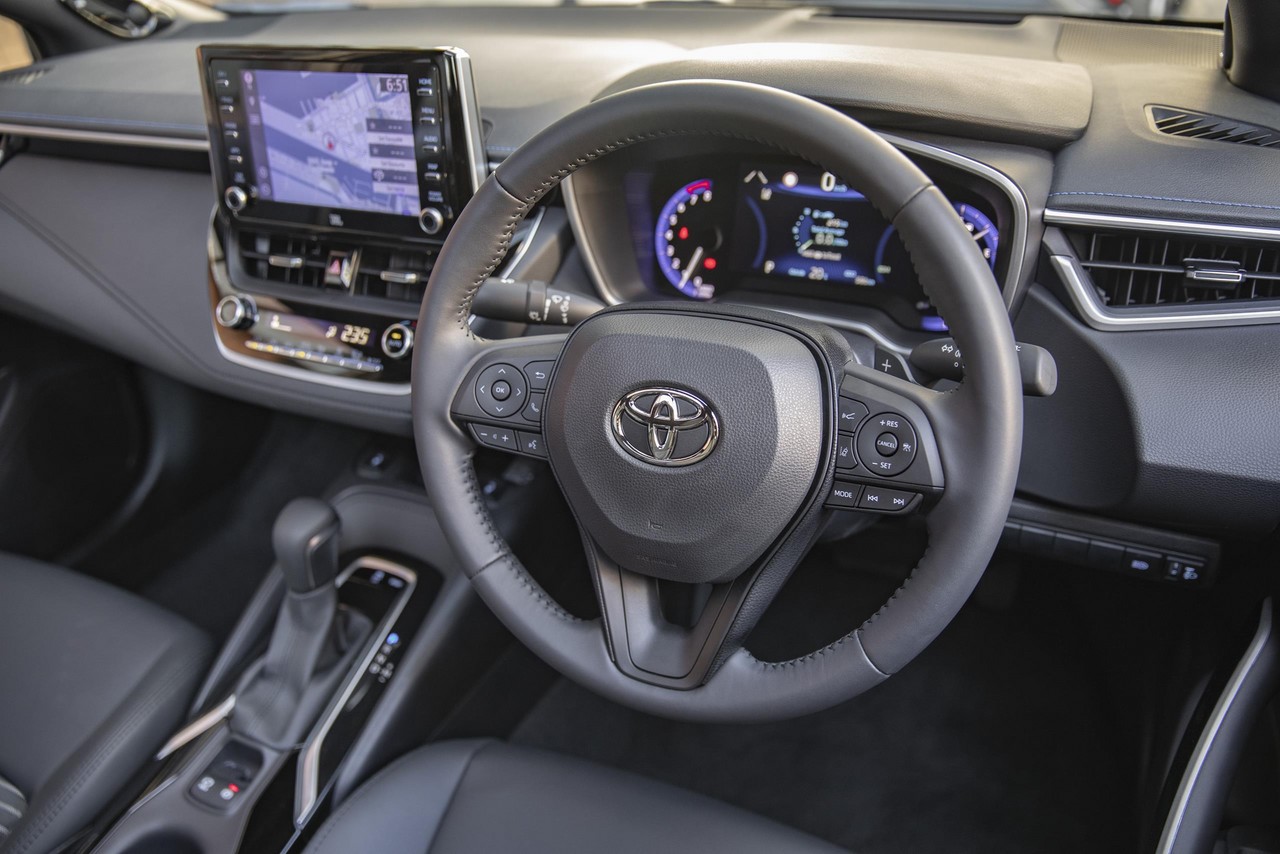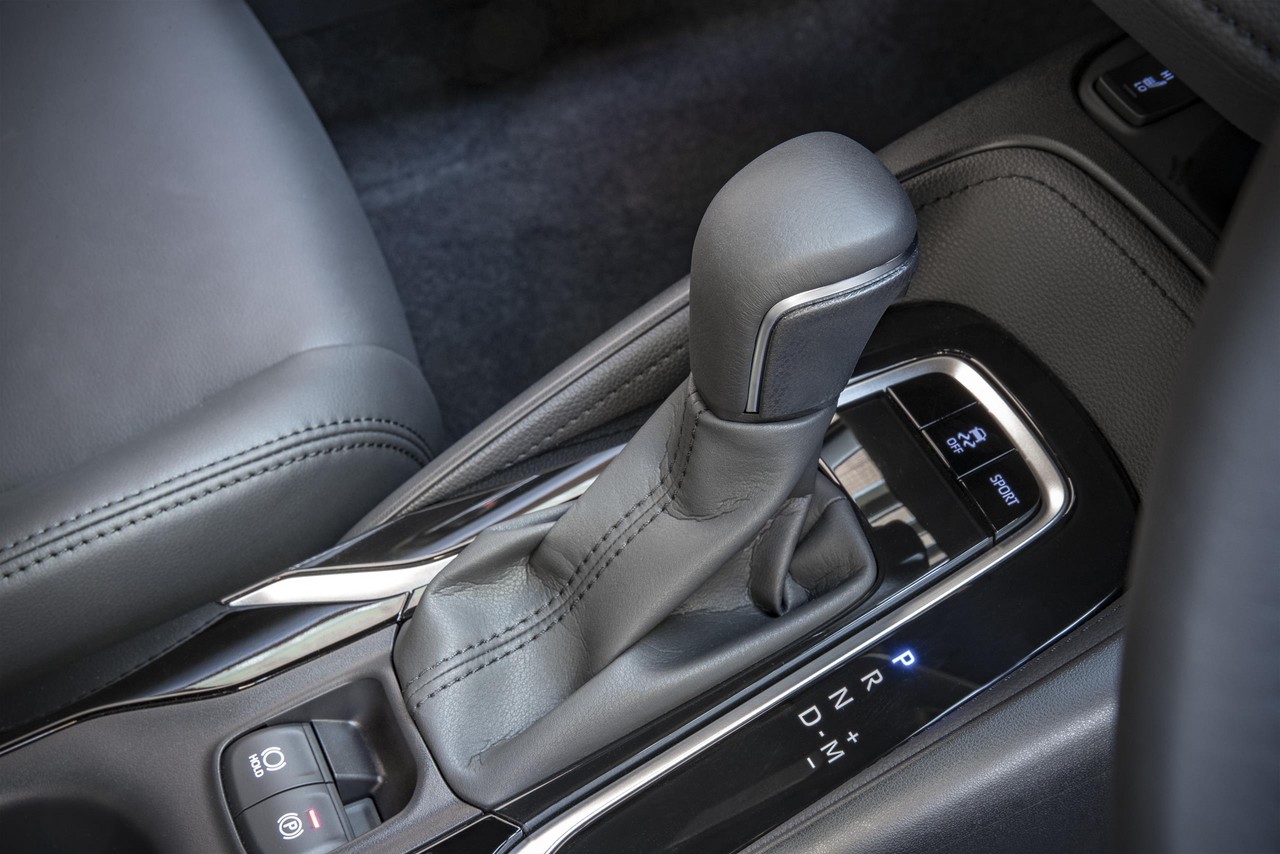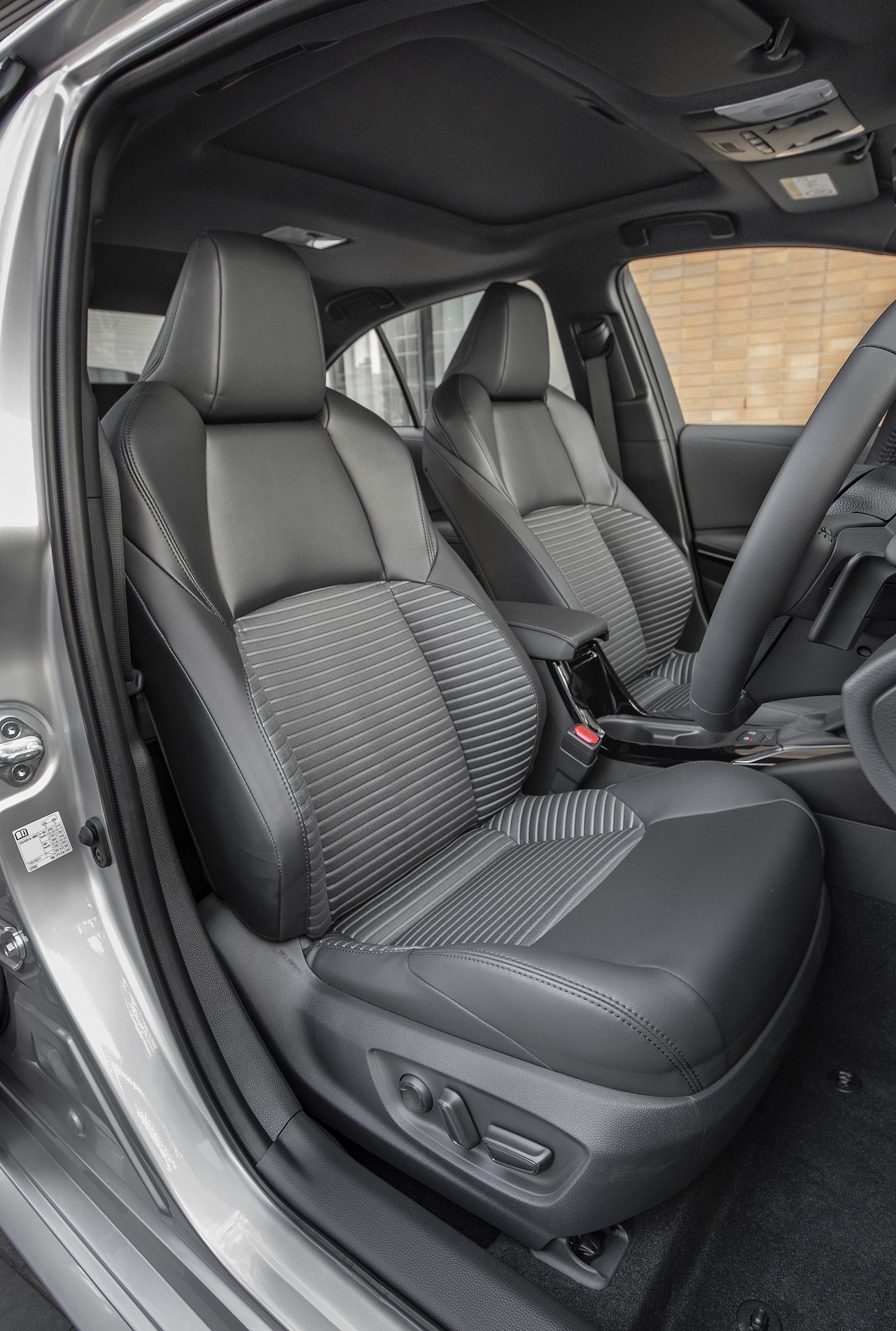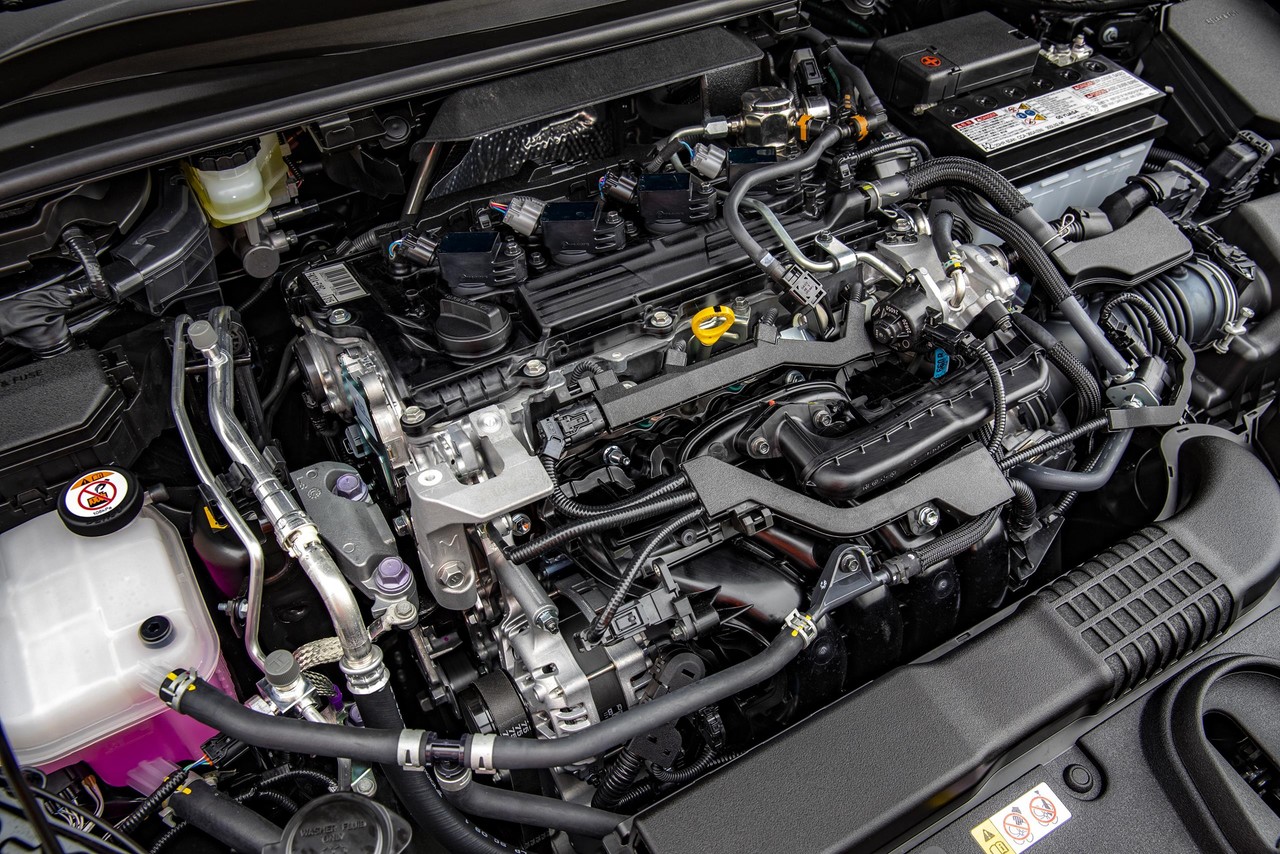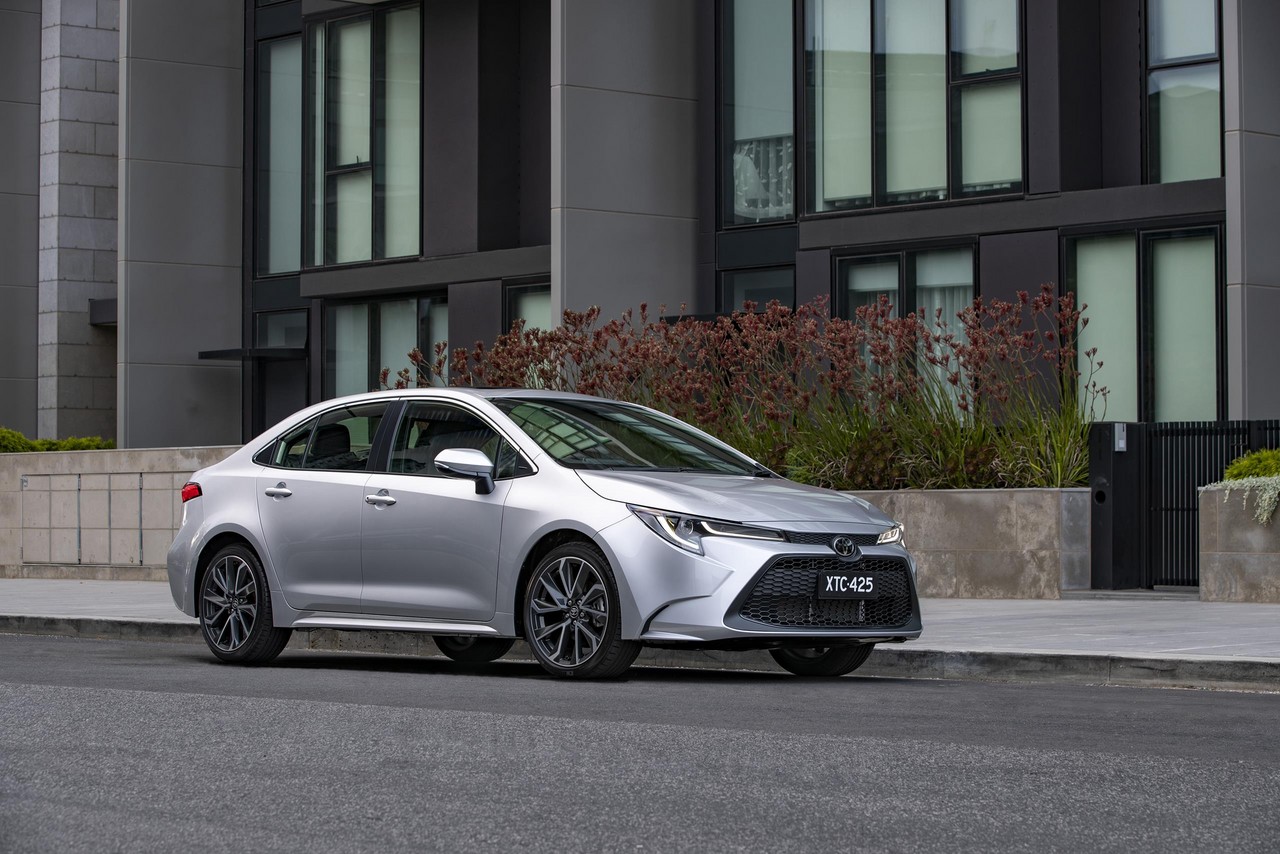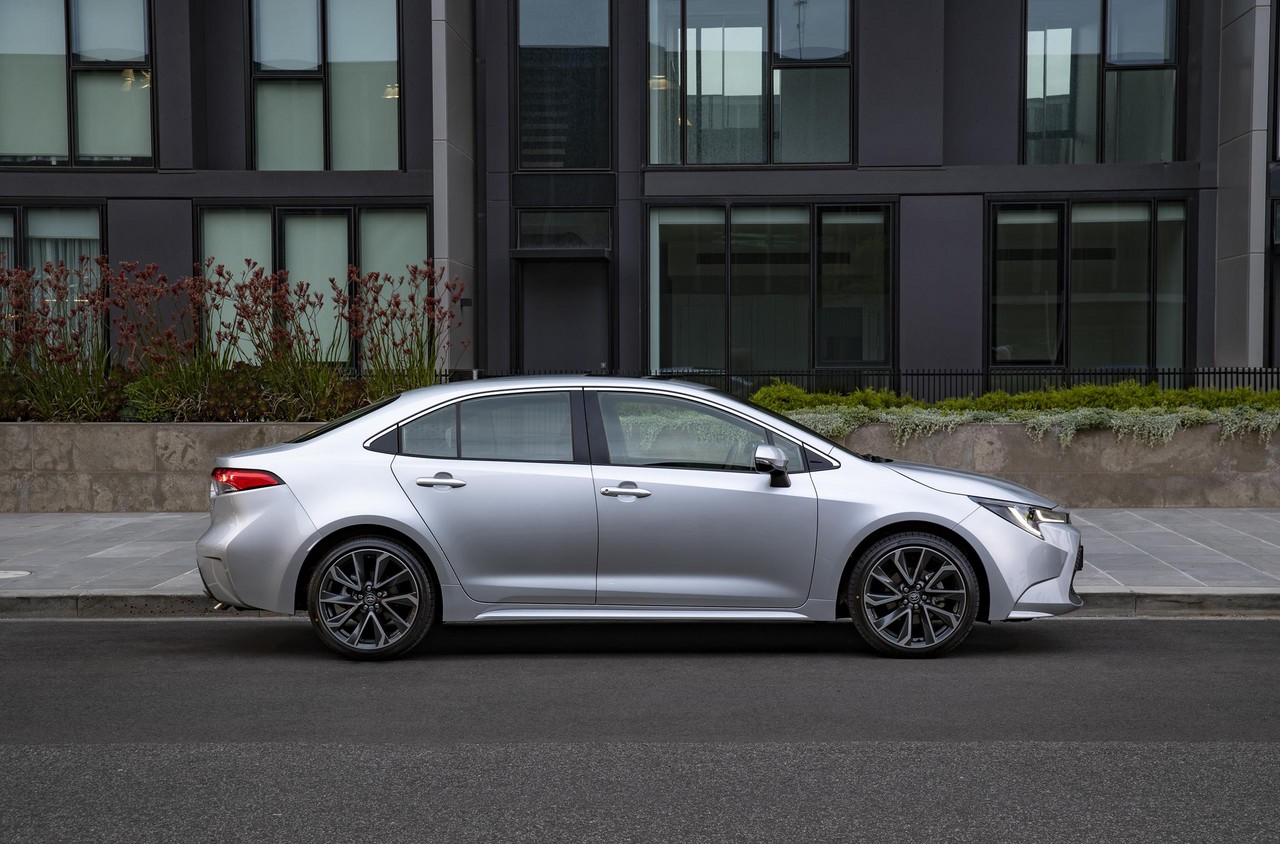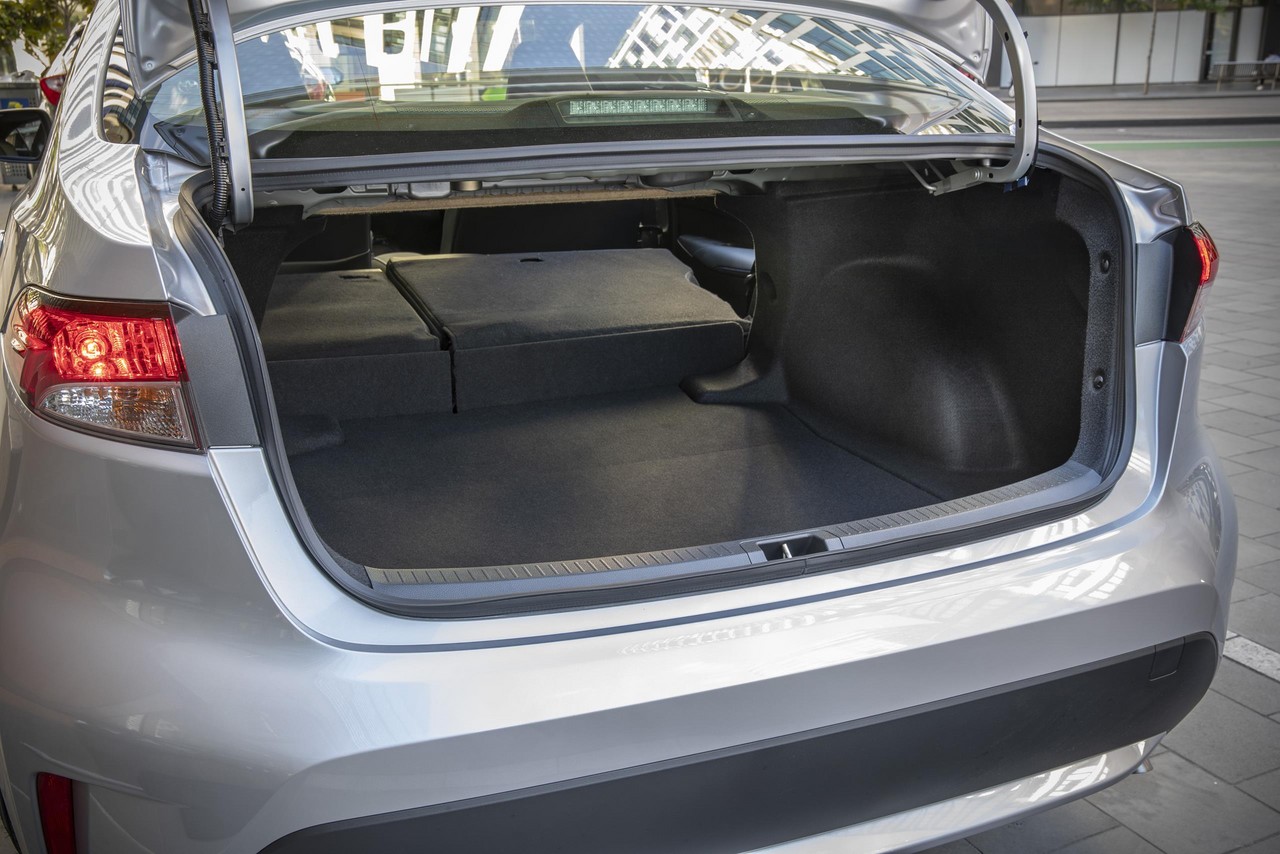
- Advanced 2.0-litre M20A-FKS engine is fuel-efficient
- Gear drive for CVT overcomes slipping sensation when accelerating from rest
- Autonomous Emergency Braking (AEB) and LED headlights fitted as standard
- Five star safety rating
- Large boot (470 litres)
- Impressive ride quality and body control…
- … though ride lacks compliance on Corolla ZR due to 225/40 R18 tyres
- Engine noise when accelerating
- Droning noise from CVT
- Blind Spot Monitoring should be standard across the range
- Rear Cross Traffic Alert (RCTA) not available
Overview
Released in Australia in November 2019, the Toyota E210 Corolla Sedan was a small, front-wheel drive vehicle. Powered by a 2.0-litre petrol engine, the Toyota E210 Corolla Sedan range consisted of Ascent Sport, SX and ZR variants (see table below) and was available with six-speed manual or continuously variable transmissions (CVTs). Please note that the Toyota E210 Corolla Hybrid Sedan has been reviewed separately.
E210 Corolla: M20A-FKS engine
The M20A-FKS engine had an aluminium alloy cylinder block with 80.5 mm bores and a 97. 6 mm stroke for a capacity of 1987 cc. Beyond this, the aluminium alloy cylinder head had chain-driven double overhead camshafts (DOHC) and four valves per cylinder –
- For the intake camshaft, Toyota’s ‘VVT-iE’ camshaft timing uses an electric motor to vary the valve timing controller for camshaft advance or retard; and,
- The exhaust camshaft had a conventional hydraulic VVT-i system in which the camshaft timing oil control valve (OCV) controlled a spool valve that enabled hydraulic pressure to be applied to the advance or retard side of the VVT-i controller. In response, rotation of the VVT-i controller vane sub-assembly (relative to the timing chain sprocket) varied valve timing. The exhaust camshaft also had a mid-position lock mechanism.
The M20A-FKS engine had Toyota’s ‘D-4S’ fuel injection system which enabled it to use port injection or direct injection depending on running conditions. Furthermore, the M20A-FKS engine had a compression ratio of 13.0:1.
Over the ADR 81/02 combined test cycle, fuel consumption for the E210 Corolla Sedan was 6.0- and 6.3-litres per 100 km for models with the CVT and manual transmissions, respectively.
| Engine | Variant | Trans. | Peak power | Peak torque |
|---|---|---|---|---|
| 1987 cc M20A-FKS petrol I4 | Ascent Sport | 6sp man. (EG60) |
125 kW at 6600 rpm | 200 Nm at 4400-4800 rpm |
| Ascent Sport, SX, ZR |
10sp CVT (K120) |
Transmissions
The E210 Corolla was available with six-speed EG60 manual and K120 continuously variable transmissions. While the manual transmission featured downshift rev-matching control, the CVT had ten simulated gear ratios and three drive modes –
- ECO: reduced throttle response (and therefore engine load) for more economical driving;
- Normal; and,
- Sport: increased throttle response for greater acceleration, while the CVT would maintain higher engine speeds.
The CVT had a direct gear drive that was used when accelerating from rest, before switching to the CVT steel belt pulley system, and the launch gear would only be re-engaged if the vehicle came to a complete stop.
Body and dimensions
Based on the ‘Toyota New Global Architecture’ (TNGA), the E210 Corolla was underpinned by Toyota’s GA-C platform which was shared with the Toyota C-HR and Toyota XW50 Prius . Compared to the E170 Corolla Sedan which it replaced, the E210 Corolla Sedan was 10 mm longer (at 4630 mm), 5 mm wider (1780 mm) and 25 mm lower (1435 mm), though wheelbase length was unchanged (2700 mm); boot capacity was also unchanged at 470 litres.
Unladen weights for the E210 Corolla ranged from 1350 kg (Ascent Sport, manual) to 1385 kg (Corolla ZR).
Suspension and steering
The Toyota E210 Corolla Sedan had MacPherson strut front suspension and multi-link rear suspension.
The E210 Corolla Sedan had rack-and-pinion steering with electric power assistance. The steering also featured an ‘active cornering assist system’ which used the actuators and sensors of the electronic stability control system to apply brake force to the front inside wheel when cornering to reduce understeer.
Safety equipment
Standard safety equipment for the Toyota E210 Corolla Sedan included dual front airbags, a driver’s knee airbag, front seat-mounted side airbags, full-length curtain airbags (i.e. for front and rear occupants), ABS, electronic brake force distribution, brake assist, electronic stability control, traction control and front seatbelts with pre-tensioners and load limiters.
As standard, the Toyota E210 Corolla Sedan was equipped with the following ‘Toyota Safety Sense’ safety technologies:
- Pre-Collision System (PCS) with pedestrian detection and Autonomous Emergency Braking (AEB): operating at speeds above 10 km/h, PCS used a front-mounted monocular camera sensor and millimetre-wave radar sensor to detect vehicles and pedestrians on the road ahead, during the day or at night; cyclists could also be detected during daylight. If there was a collision risk, the driver would receive an audible warning and a ‘Brake’ message would be shown on the multi-information display. In its second stage, Pre-Collision Brake Assist would prepare the braking system so that it would respond faster if the brake pedal was depressed. If the driver did not react and a collision was imminent, maximum braking force would be applied automatically to reduce the severity of the collision;
- Active Cruise Control (ACC): using the same millimetre-wave radar as PCS, ACC could maintain a safe distance from the vehicle ahead when cruise control was active – for models with CVTs, this included applying the brakes to bring the vehicle to rest if necessary and accelerating back to the pre-selected cruising speed when safe to do so. For Toyota Corolla Sedans with manual transmissions, however, ACC only operated at speeds above 30 km/h;
- Lane Trace Assist with steering assist and lane centring (models with CVT only): Lane Trace Assist operated when Active Cruise Control was engaged and used the forward-facing camera to detect lane markings. Lane Trace Assist would then provide steering assistance to keep the vehicle in the centre of its lane, even on curved roads. Where lane markings were not visible, Lane Trace Assist used the position of the vehicle ahead so that the E210 Corolla would follow its path;
- Lane Departure Alert (LDA) with steering assist (models with manual transmissions): used the windscreen-mounted camera to monitor the vehicle’s position relative to lane markings on the road surface. If the vehicle was about to depart from its lane without the turn indicator having been applied, an audible tone would alert the driver and a warning would appear in the multi-information display. If the vehicle continued to move outside its lane, light steering force would be applied to encourage the driver to move back into the lane. LDA also included a sway warning function that would prompt the driver to take a break if the system detected that the vehicle was drifting within its lane due to driver inattention;
- Automatic High Beam: operating at speeds above 30 km/h, Automatic High Beam would automatically switch between low and high beam lighting according to ambient light conditions. As such, Automatic High Beam used the windscreen-mounted camera to detect the headlights of oncoming vehicles or traffic ahead and, if detected, would automatically switch to low beam to avoid dazzling other road users; and,
- Road Sign Assist (RSA): the windscreen-mounted camera could recognise speed limit signs so that the speed limit would be displayed on the multi-information display (MID) in the instrument cluster.
The Toyota E210 Corolla SX and ZR were further equipped with a Blind Spot Monitor which used radar sensors mounted on the rear corners to detect vehicles up to 60 metres behind the E210 Corolla and in adjacent lanes. If detected, the driver would be alerted to their presence by the illumination of LED warning indicators in the door mirror on the side of the E210 Corolla, and the LEDs would remain illuminated while there was another vehicle in the driver’s blind spot. If the driver operated the indicators to move into the lane where there was another vehicle in the driver’s blind spot, the LEDs would flash rapidly.
ANCAP safety testing
For ANCAP’s safety ratings , the results of the Toyota E210 Corolla hatch were also applied to the Toyota E210 Corolla sedan. As such, the E210 Corolla Sedan received a five star safety rating which included a 96 per cent adult occupant protection rating and an 83 per cent child occupant protection rating. In the frontal offset test, protection of the driver’s head, thighs, feet and left lower leg were rated as good, though protection of the chest and right lower leg were rated as adequate (i.e. a slight risk of serious injury). In the side impact and pole tests, however, maximum points were awarded.
Wheels, tyres and brakes
The Toyota E210 Corolla Sedan had 283 mm by 22 mm ventilated front brake discs and 265 mm by 10 mm solid rear discs. The E210 Corolla Ascent Sport and SX had 16-inch x 7.0J alloy wheels with 205/55 R16 tyres. The E210 Corolla ZR, however, had 18-inch x 8.0J alloy wheels with 225/40 R18 tyres.
Features: Corolla Ascent Sport
The standard infotainment for the Toyota E210 Corolla Sedan consisted of an eight-inch colour touchscreen, a six speaker audio system with AM/FM radio, Bluetooth mobile phone connectivity, voice recognition, Apple Car Play and Android Auto smartphone integration, MyToyota app, a USB input and a 3.5 mm auxiliary input.
Beyond this, standard features for the Toyota E210 Corolla Ascent Sport Sedan include embossed fabric seats, air conditioning, dusk-sensing LED headlights, LED daytime running lights, rear fog lamps, reversing camera, 60/40 split fold rear seats, remote central locking, power adjustable and heated door mirrors, power windows, tilt and telescopic steering wheel adjustment, an electronic park brake, a 12 volt accessory socket, a 4.2-inch multi-information display (MID) and an immobiliser.
Features: Corolla SX
Compared to the Corolla Ascent Sport, the Corolla SX was further equipped with an enhanced touchscreen (enabled pinch, swipe and flick gestures), satellite navigation with SUNA live traffic alerts, digital radio tuner, wireless mobile phone charger, single-zone climate control air conditioning, steering wheel controls, proximity key, push-button start and steering wheel gearshift paddles.
Features: Corolla ZR
The range-topping Toyota Corolla ZR Sedan was distinguished by its JBL audio system with nine speakers, synthetic leather upholstery with ‘Rezatec’ inserts, front sports seats with heating, an eight-way power adjustable driver’s seat, head-up display (HUD), power-operated (tilt and slide) moonroof, ambient lighting and electrochromatic rear view mirror.
Brochure and specifications
- Brochure: Toyota E210 Corolla Sedan (November 2019)
- Specifications: Toyota E210 Corolla Sedan (November 2019)

